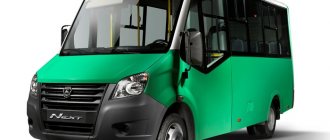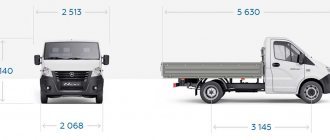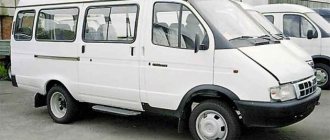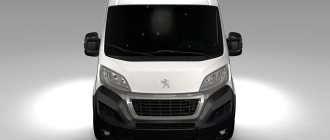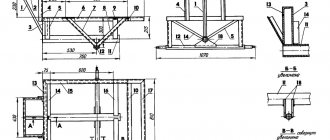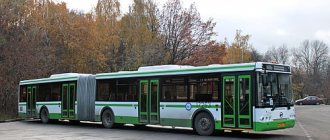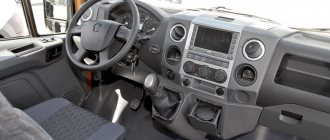Peugeot Boxer van. Photo by Groupe PSA
Peugeot Boxer is a commercial van designed by the Fiat Centro Stile design bureau. Produced by a joint venture of the joint venture Sevel SpA , created in 1978 by the Italian Fiat Group and the French PSA Peugeot Citroën. modern design in 2006. It is produced under four brands : Peugeot Boxer, Citroen Jumper, RAM Promaster (in the USA) and the third generation Fiat Ducato III. Factories are located in Italy, France, and Russia. Based on a commercial van, light-duty trucks and buses for various purposes are produced.
Detailed description, device, modifications
The Peugeot Boxer bus is presented in two modifications: minibus (city) and tourist/intercity.
A bus based on Peugeot Boxer in versions for minibuses is capable of transporting from 9 to 22 people (not counting the driver) in full compliance with the requirements of GOST R 41.52-2001 .
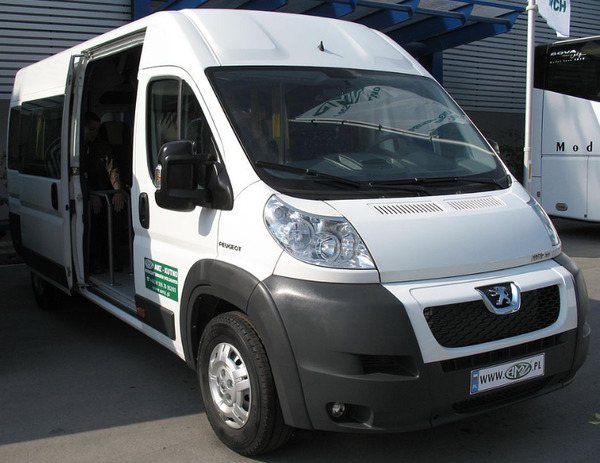
Peugeot Boxer bus. Photo Wikipedia
This was achieved thanks to the advantageous difference between the Peugeot Boxer and its classmates in terms of internal body height - this car can carry standing passengers! If we take into account that drivers, in violation of all norms, “ram” passengers during rush hours, then 22 people is far from the capacity limit for the Peugeot Boxer. In addition, the presence of a wide free passage in the cabin can be used to accommodate luggage on routes serving train stations and airports.
When manufacturing buses based on Peugeot Boxer, only those technologies are used that have proven themselves in operation on other minibuses:
- In finishing the ceiling and side surfaces, materials are used that are not subject to temperature deformation and dampen noise.
- The floor manufacturing technology does not violate the integrity of the galvanized bottom of the car with fasteners, and all seams are additionally sealed.
- The flooring allows you to clean the interior using a jet of water under pressure.
- All new materials used in the construction of Peugeot Boxer buses undergo laboratory testing, road tests on a specific sample and are certified.
Options for the Peugeot Boxer include passenger compartment air conditioning, automatic climate control, auxiliary air heater, engine pre-heater, audio-video equipment, seats of various configurations, a range of finishing materials and much, much more.
The body layout of the Peugeot Boxer, having the advantages of maximum safety and controllability, allows the carrier to win not only in the number of passengers, but also in reducing the time spent on boarding and disembarking.
One of the advantages of the Peugeot Boxer is the cab-forward half-hood layout . This arrangement gives the Peugeot Boxer a number of very important properties:
- For an empty and a fully loaded car, the weight distribution along the axes remains almost the same.
- Increased capacity in the passenger compartment and/or cargo compartment.
If you look at the Peugeot Boxer from the side, you will notice that the spacious and roomy cabin is slightly shifted forward, and the engine compartment is very small. Everything is explained simply - the engine is placed across the body and the drive is carried out on the front axle, so the engine compartment is very compact . At the same time, excellent access to the engine compartment for servicing the units is maintained. There is no driveshaft, and all the design disadvantages characteristic of rear-wheel drive.
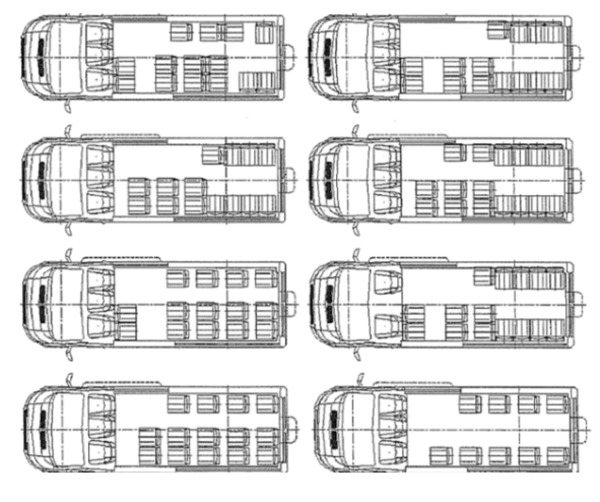
Peugeot Boxer bus interior diagrams. Photo by Groupe PSA
In the Peugeot Boxer, this arrangement made it possible to lower the floor level of the passenger compartment - the car's center of gravity became lower, and its position, depending on the load, was almost unchanged. Thanks to this, the road stability even at maximum loads makes the Peugeot Boxer one of the best in its class. This property distinguishes the Peugeot Boxer from most of its classmates, whose engines are located longitudinally and the drive is carried out on the rear axle.
Peugeot Boxers are famous for their safe handling and cross-country ability , especially in winter. Unlike cars with rear axle drive, Peugeot Boxer gives drivers much less problems with wheel slipping when driving on slippery roads or when maneuvering on icy areas. The driver will not have to waste the precious time and nerves of passengers on extracting his car from ice captivity. Let's add here another advantageous feature - the Peugeot Boxer has better cross-country ability in winter thanks to single-pitch rear wheels.
In slushy and deep snow, the front and rear wheels of the Peugeot Boxer travel “track after track”, without creating unnecessary resistance and prerequisites for slipping, which is often observed in “dual-slope” competitors.
In summer, the Peugeot Boxer single tire significantly saves fuel and makes driving more comfortable.
The Peugeot Boxer Tourist bus is designed for intercity transportation, and can also be used for sightseeing and tourist trips. It features comfortable seats with adjustable backrest angle, folding armrest and seat belt. For the convenience of stowing hand luggage, luggage racks . The passenger compartment is decorated with high-quality materials and is equipped with an air conditioning system.
Peugeot Boxer buses were designed to meet stringent European requirements for vehicle safety, reliability and efficiency. This car will change your idea of buses. European assembly, powerful diesel engine that meets Euro-4 environmental standards, modern, catchy and interesting appearance, no steps in the passenger compartment with the lowest floor level among competitors and a cabin height of more than 1,900 mm, front-wheel drive, reinforced suspension, disc brakes on all wheels, ABS and emergency braking assistance system and many other pleasant little things included in the basic package - all of these are endowed with the Peugeot Boxer.
Equipment
| Parameter or element of a converted interior | Minibus taxi | Suburb |
| Glazing | Full glazing of the body, safety glass tempered with “silk-screen printing” glued in, 2 windows, rubber seals, tinted from the glass supplier | |
| Interior trim with plastic panels | Availability | |
| Ceiling | Plastic/composite material | |
| Passenger compartment door trim | Standard plastic panels, Caps for the upper parts of the side sliding door and rear swing doors (gray plastic), Door window openings without plastic trims | |
| Number of seats in the cabin | 16 | 14 |
| Lap seat belt inserts | On 16 seats | |
| Ventilation escape hatch | One | |
| Filter-ventilation device (FVU) | One | |
| Flooring | Anti-slip, wear-resistant floor coating for the passenger compartment | |
| Electric sliding door drive | Eat | – |
| Interior lighting | Three LED lamps | |
| Salon handrails at the sliding door and ceiling | Eat | |
| Thermal and noise insulation of the interior | Stizol | |
| Passenger seats | Passenger seats with fabric upholstery | Soft upholstered seats, high backrests with folding armrests along the aisle, reclining backrests, 3-point seat belts |
| Interior heater | 1 pc., with an additional pump and shut-off valve for a winter-summer water heater system | Autonomous interior heater (at least 3.9 kW) with wiring along the podium |
| Driver signal button | Two buttons | |
| Side stand | One | |
| Glass breaking hammer | One | |
| Low partition with lampshade | One | |
| Device against accidental opening of emergency exit | Belt block on rear swing doors – 1 pc. | – |
| Salon mirror | One | – |
| Outline lights | One | – |
Advantages and disadvantages of the model
If we compare Peugeot Boxer cars with competing brands of trucks with similar characteristics, this model is better in terms of price and quality.
Peugeot Boxer salons are more comfortable and roomy than those of competitors, this is due to the leaders of the French automobile industry, since they really give preference to ergonomic indicators. The model is equipped only with advanced equipment and a powerful traction motor, which is capable of accelerating even a loaded vehicle to maximum speed in a short time with low fuel consumption.
But the Peugeot Boxer model also has disadvantages that are associated with the adaptation of a European car to domestic roads, temperatures and quality of maintenance. Particularly problematic components of the Peugeot Boxer in Russian operating conditions are steering ends, electronics and ball joints. The car takes a long time to warm up in winter, but the interior still remains cold.
Its first model appeared in 1978, and it was designed by the Italian and French PSA Peugeot Citroën.
Along with other vans, this example has become widely known for its style, comfort and reasonable price. Its appearance was last updated in 2006, and in 2014 it acquired the latest modification.
This car is offered in different body styles, varying in width and height.
The Peugeot Boxer is a durable car that has undergone numerous tests on doors, hinges, latches and so on.
Peugeot Boxer Specifications Dimensions and load area
The Peugeot Boxer van is available in 4 lengths (L1, L2, L3, L4) and 3 heights (H1, H2, H3).
Engine
Under the hood of the Peugeot Boxer there is a 2.2-liter turbodiesel power unit with capacities of 110, 130 and 150 horsepower and a 3.0-liter engine with a capacity of 180 hp. (but rumor has it that it won't be very popular). Engines 130 hp will be equipped with a Start/Stop system.
All engine options comply with Euro 5 emission standards.
Load area
Body volume, depending on the model, ranges from 8 to 17 cubic meters. m; and the payload mass ranges from 930 to 1870 kg.
A car with 5 doors. There is a sliding door on the side and swing doors at the back. They facilitate the process of loading and unloading large volume cargo.
Safety
Like all cars of similar models, the Peugeot Boxer is equipped with various security systems. These include: electronic stability control, which prevents the car from sideways skidding, traction control, LDWS (monitors road markings), tire pressure monitoring system, hill start assist, hill descent control (controls the vehicle's movement on slopes) and curtain airbags.
Salon
The seats are upholstered with material from the DARKO company. The driver's seat is very comfortable and can be adjusted in different ways. Electric mirrors are equipped with a heating function.
The audio system is modern with MP3, Bluetooth and USB connector. There is also a small 5-inch touchscreen built into the dashboard, which could have been larger. There is a 12V socket in the trunk.
The van has various places for storing small items and a place for a cup holder, which is not very conveniently located (in the central part of the dashboard, although it would be more convenient to place it on the upper part next to the steering wheel).
Verdict
The price of an all-metal Peugeot Boxer van ranges from RUB 1,164,000.
This updated van has improved looks, low running costs, is rugged, reliable and durable. And on the road he feels stable, confident and safe.
Technical data
| Length | Code LCVD | TVV code | Version | Gross weight (kg) | Engine HP | Cargo compartment volume (m³) | |
| L1 | 2PU91DHDQ609UJC1 | YATMFA/GRF/GRF1 | FG L1H1 2.2HDi | 2 495 | 130 | 635 | 8 |
| 2PU91DHDQ609UAC1 | YATMFA /GRN1 /GRN | FG L1H1 2.2HDi | 2 790 | 130 | 930 | 8 | |
| 2PU91DHDQ609FCC1 | YATMFA /GR1 /GR | FG L1H1 2.2HDi | 2 840 | 130 | 980 | 8 | |
| 2PU91HHDQ609ULC1 | YETMFA/GY/GY1 | FG L1H1 2.2HDi | 4 005 | 130 | 2 060 | 8 | |
| L2 | 2PU93IHDQ609UJC1 | YATMFB/HRF/HRF1 | FG L2H2 2.2HDi | 2 495 | 130 | 570 | 11,5 |
| 2PU93IHDQ609UAC1 | YATMFB /HRN1 /HRN | FG L2H2 2.2HDi | 2 790 | 130 | 865 | 11,5 | |
| 2PU93IHDQ609FCC1 | YATMFB/HR1/HR | FG L2H2 2.2HDi | 2 905 | 130 | 980 | 11,5 | |
| 2PU93MHDQ609ULC1 | YETMFB /HY /HY1 | FG L2H2 2.2HDi | 4 005 | 130 | 1 920 | 11,5 | |
| L3 | 2PU95KHDQ609UJC1 | YCTMFC /HRF /HRF1 | FG L3H2 2.2HDi | 2 495 | 130 | 520 | 13 |
| 2PU95KHDQ609UAC1 | YCTMFC /HRN /HRN1 | FG L3H2 2.2HDi | 2 790 | 130 | 815 | 13 | |
| 2PU95KHDQ609AOC1 | YCTMFC /HY1 /HYR /HYR1 /HY | FG L3H2 2.2HDi | 3 500 | 130 | 1 525 | 13 | |
| 2PU95MHDQ609ULC1 | YETMFC /HY /HY1 | FG L3H2 2.2HDi | 4 005 | 130 | 1 870 | 13 | |
| 2PU95NHDQ609AOC1 | YCTMFC /LY1 /LYR /LYR1 /LY | FG L3H2 2.2HDi | 3 500 | 130 | 1 500 | 15 | |
| L4 | 2PU97LHDQ609AOC2 | YDTMFC /HYL /HYL1 /HYLR /HYLR1 | FG L4H2 2.2HDi | 3 500 | 130 | 1 440 | 15 |
| 2PU97MHDQ609ULC1 | YETMFC /HYL /HYL1 | FG L4H2 2.2HDi | 4 005 | 130 | 1 900 | 15 | |
| 2PU97MHDR609ULC1 | YEUMFC /HYL /HYL1 | FG L4H2 2.2HDi | 4 005 | 150 | 1 900 | 15 | |
| 2PU97OHDQ609AOC2 | YDTMFC /LYL /LYL1 /LYLR /LYLR1 | FG L4H3 2.2HDi | 3 500 | 130 | 1 410 | 17 | |
| 2PU97PHDQ609ULC1 | YETMFC /LYL /LYL1 | FG L4H3 2.2HDi | 4 005 | 130 | 1 870 | 17 | |
| 2PU97OHDR609AOC2 | YDUMFC /LYL /LYL1 /LYLR /LYLR1 | FG L4H3 2.2HDi | 3 500 | 150 | 1 410 | 17 |
Generations of Peugeot Boxer
The French Peugeot Boxer is a very popular model of commercial van in the Russian Federation and the most dangerous competitor to the domestic GAZelle. Since the beginning of 2000, Russia has become one of 3 places where cars are produced. The reasons for the success of the car on the world market are the high comfort, excellent build quality and optimal dimensions of the Peugeot Boxer.
Basic information, characteristics
- Manufacturer/manufacturer where the equipment is produced/manufactured. Sevel is the common name of two factories created jointly by PSA Peugeot Citroën (the name from 2020 is Groupe PSA) and Fiat, as well as the cars produced by these factories. The Sevel Sud plant was founded in accordance with an agreement signed by PSA and Fiat in 1978.
- Purpose. City, suburban, tourist, intercity, excursion, special, school, ritual.
- Class. Small.
- Body type. Load-bearing body, which is made with extensive use of high-strength steel.
Engine/powertrain characteristics
- Type. Diesel.
- Number and arrangement of cylinders. 4, in-line.
- Environmental safety standards. Euro-4.
- Working volume, l. 2,2.
- Engine power, hp/min. 130.
- Maximum torque, Nm/min. 320 at 2000 rpm.
- Engine location. Transverse.
- Checkpoint. 6-speed manual transmission.
- Front-rear axle suspension. The front wheels of the vehicle are suspended by means of an independent MacPherson-type suspension with anti-roll bar, and the rear wheels are suspended by a dependent design with hydraulic shock absorbers and leaf springs.
Device. Peugeot Boxer suspension and chassis
Peugeot Boxer is a car with a monocoque body, a transverse engine, a MacPherson-type front suspension and a rack and pinion steering mechanism - i.e., a standard set of technical solutions that have been tested in millions of passenger cars. But the design of the rear suspension uses small-leaf springs, already familiar to commercial trucks, which rest on the transverse beam of the non-driving axle with a square section. On short-wheelbase versions there is one sheet, on medium-wheelbase versions there is one sheet plus a spring, on long-wheelbase versions there are two sheets.
The design of the all-metal van has been specially designed to prevent dust, dirt and moisture from accumulating in hard-to-reach places. Almost 2/3 of the construction material is galvanized steel. All external surfaces are double galvanized and coated with a five-layer anti-corrosion protective compound. The Peugeot Boxer van's upholstery material uses steel sheets up to 1.8 mm thick.
The front suspension of the car is perfectly adjusted. In combination with power steering, it guarantees consistently high maneuverability and ease of control. The basic Boxer configuration includes ABS - an anti-lock braking system, and the car can be equipped with an ASR slip control system, parking sensors, an overtaking sensor, a rear view camera, ultrasonic detectors, etc.
In Europe, the Peugeot Boxer suspension can be spring or air. In Russia, pneumatic is not even offered as an option, since it is “uncomfortable to work” at extremely low frosty temperatures. The Peugeot Boxer has ventilated disc brakes at the front and disc brakes at the rear.
Equipment
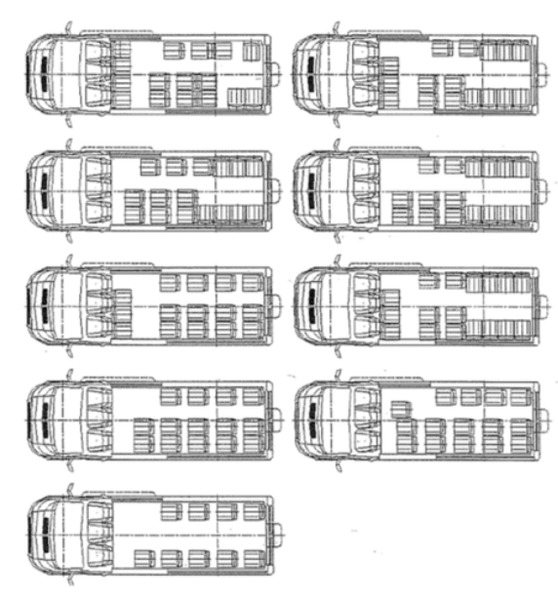
Possible layouts of a refurbished interior. Photo by Groupe PSA
Route taxi:
- Full body glazing
- Thermal and noise insulation of the interior
- Interior trim with plastic panels
- Fabric ceiling trim
- Ventilation escape hatch
- Filter and ventilation device
- Floor finishing with anti-slip coating
- Electric sliding door drive
Tourist:
- Full body glazing
- Interior trim with plastic panels
- Anti-slip, wear-resistant interior floor covering
- Interior heater powered by a 4kW cooling system.
- Three LED lamps
- Air conditioner
- Side stand
- Salon handrails at the sliding door
- Curtains on the windows
- Thermal and noise insulation of the interior
- Sliding door drain
- Glass breaking hammer
- Handle on the sliding door on the interior side
